NEWSPAPERS IN EDUCATION
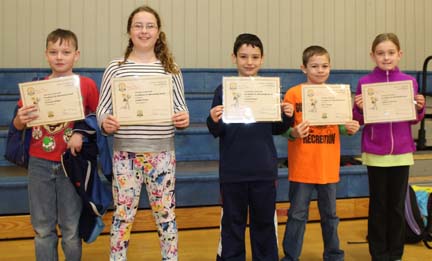 Photo courtesy of Walter Boomsma
Photo courtesy of Walter Boomsma
VALLEY GRANGE AD WINNERS — The Valley Grange of Guilford honored the winning Piscataquis Community Elementary School artists for the organization’s annual ads in the Piscataquis Observer Newspapers in Education supplement during an assembly on March 25 at the school in Guilford. Grade 3 winners are first place, Gabriella Koscielny; second, Baylynn Grant and third, Gavyn Gilbert. Grade 4 winners are first place, Summer Nesbit; second, Connor Hamlin; and third, Zachariah Demmer. Pictured are, from left, Demmer, Nesbit, Hamlin, Gilbert and Koscielny. Not pictured is Grant. All third- and fourth-grade students who participated and “did their best work” received a mini-certificate and magnet from Valley Grange.
Milo Elementary School students ‘Americanism Essays’
Note: Many of the students were inspired by President Lincoln’s second inaugural address on March 4, 1865 and his words, “To care for him who shall have borne the battle and for his widow, and his orphan. Today a pair of metal plaques with these words are located at the entrance to the Department of Veterans Affairs (VA) headquarters in Washington, D.C. The words became the VA motto in 1959.
By Victoria Silva
Grade 3
America, we call it “Land of the Free.” If it wasn’t for our soldiers fighting for our country we wouldn’t have this. The military branch, Navy, Air Force, Army, Marines and The National Guard, they take care of us while overseas. The government takes care of the veterans’ families such as housing, medical and other needs like education. Soldiers have enough on their minds during to care for our country to worry about their families back home. Because of President Lincoln honoring his promise, this gives men and women the want to protect our country.
My grandfather and great-grandfather served in the military and if it wasn’t for this promise, who knows where we would be today. Thank you very much, to all the soldiers and veterans.
The government made sure the soldiers were taking care of mentally and physically when needed. There are VA hospitals located in all cities and states across America to care for our vets. Many doctors and surgeons dedicate their time to care for these men and women because of what they have sacrificed for our country.
It is pretty bad that the NFL, NHL and NBA (players) get paid more than our soldiers that are protecting the United States of America. The should change soon before more of our men and women die for what they believe in, freedom!!!!
By Addison Conklin
Grade 4
We keep Lincoln’s promise by helping the veterans with the things they need. Like if they lose their jobs we can help them with finding another job. If they need a home we can give them a home. If the veterans need any help we can help them with the things they need. The veterans helped us so we need to help them.
By Jake R. Williams
Grade 4
We need to show the veterans so much compassion, when they come out of war they will feel happy and not depressed.
And the U.S.A. can do that by providing the care that they need so the veterans will not lose their home, family and their care for others.
I know ways to make veterans safe again: Offer your friend to take care of their husband or wife by giving the veterans care.
Show the veterans we still care about them instead of showing them that we don’t care about them.
If the veteran was older than you could help him or her a lot more than a younger one.
If you see a veteran at a store and he has a broken arm or no arm, broken legs or maybe even no legs! You could help him or her with what they are trying to get, if it is far or too high for them not to reach.
What I’m trying to say is U.S.A. should keep Abraham’s promise.
I want to take care of the veterans in need of help.
So what can you do to help a veteran in need of help?
By Michael Gibbs
Grade 4
We could send medical supplies to the veterans that need it. And find jobs for them and give them food and money. And we should show care and love and salute them when we see them and write them if they didn’t have any family.
By Madison Witham
Grade 4
To respect and help out veterans because veterans and their families need help like ones with one arm or one leg. So help if you care but if you don’t veterans can go homeless and live in the stress. That is why we should keep Lincoln’s promise to our veterans. I care. Do you care?
By Joe Heffenreffer
Grade 4
How do we keep Lincoln’s promise to our veterans and their families? We could give them a job. Maybe we could give them a shelter. Also we could let them have some food if they do not have any. Last we could throw a party for the veterans. That is how I would keep Lincoln’s promise.
By Michelle Saunders
Grade 4
We need to keep our veterans safe, by giving them all the love and care they need, even when we don’t know them. We do this by giving our veterans a home, water, food and clean cloths. And make sure they are healthy by bringing them to the hospital or therapy. They served our country to save us. We need to save them too.
When they come to the war with all arms and legs they might come back with one leg and one arm. Some veterans are happy to go home and see their family, and some of the veterans become homeless because they can lose their house or can’t take care of themselves. We need to help them if they are sad or upset because not all veterans, every veteran deserves love and care even when we don’t know them.
Save our veterans!
By Jacob Higgins
Grade 4
After the veterans come back from war I think we should give them their job back because they served in the war and even when they lose arms and legs we should treat them like regular people. Like they can get their stuff back but I don’t think they should get special stuff because they served in the war like I said either. They might just want to be treated like regular people.
I think they will want their job back because they saw terrible and heroic things and then they come back and they are sad and when they’re sad they don’t want to go through more rough times with job interviews seeing if he’s good at the job even if he’s trying to get his job back he has to go through all of it again while being sad. That must be hard and frustrating.
I think they want to be treated regularly because they just got back from war. They probably hated it and if I was a veteran I would of saw friends I made in war dead and not all of them but a little of them will die and I got reminded about being a war hero every day it will make me really, really depressed because it will remind me about all my friends and people that died during that day.
And that is how I’d keep Abraham Lincoln’s promise.
By Melony Coburn
Grade 4
We keep his promise by supporting them. Spare some change it’s OK to help veterans but it’s not OK to not help them. They are losing their lives because we’re not helping them. They help us so we should help them. We need to stand up and help veterans in need. And treat them how you want to be treated. And I especially know this if you help them you will feel so good about yourself. And that veteran you help will feel more good about him or herself. So just remember this now. Are you going to be a caring person of someone who doesn’t care. It’s your choice.
Help our veterans! They need our help.
Newspaper opens pages to student writers, artists
Newspapers can be found on people’s coffee tables, on store racks and, just as importantly, in the classrooms of most school systems.
In today’s ever-changing technological world, the Piscataquis Observer feels that it is important for the younger generation to know more about the newspaper industry and the history that comes with holding a product in your hands, turning the pages, and cutting out photos and articles to hang on their parents’ refrigerators.
Once again, the Piscataquis Observer has teamed up with area schools to celebrate Newspapers in Education Week, by creating this special supplement.
NIE is a cooperative effort between schools and newspapers to promote the use of newspapers as an educational resource. The international program, which began in 1955, also seeks to help improve the students’ reading, spelling and writing abilities, as well as their artistic talents.
This year, pupils at Dexter Regional High School, the Penquis Valley School in Milo, Piscataquis Community Secondary School of Guilford and SeDoMoCha Middle School in Dover-Foxcroft were asked to become newspaper advertising artists and copywriters as they created “advertisements” for willing sponsors.
While Newspapers in Education is a weeklong event, the Piscataquis Observer works with classrooms — students, teachers and administrators — throughout the year. Whether it be a school board meeting, a basketball game, spelling bee or a band concert, newspaper reporters are covering education on the front line.
Indeed, without news of our youth and their schools, our newspapers would be missing a very vital part of the communities in which we serve.
Having newspapers in the classroom is an exceptional supplement to textbooks and iPads. A newspaper in the classroom connects young people with their community, their nation and the world.
Over the years, members of our staff have worked closely with school personnel and students to build two-way connections between the classroom and newsroom.
Some examples of this are when a reporter comes to a school to interview students for their opinion on a topic for our “Kid’s Say” segments or when one of our staff members is asked to host a job shadow experience.
This supplement to our newspaper is the result of the Newspapers in Education exercise, and we hope you will enjoy the student-created newspaper advertisements, essays and photos in this special booklet.
We also wish to thank the pupils, teachers and administrators who agreed to partner with us, as well as the businesses that provided the opportunity for the children to showcase their artistic abilities.
Idea to use newspapers as living textbook
Originated in Maine nearly 221 years ago
The value of using the newspaper as an educational tool was voiced more than 220 years ago by a wise newspaper publisher in Portland, Maine who wrote an editorial on the subject, published June 8, 1795. The message is just as relevant today:
“Much has been said and written on the utility of newspapers: but one principal advantage which might be derived from these publications has been neglected: we mean that of reading them in schools, and by the children in families.
“Try if for one session — Do you wish your child to improve in reading solely, give him a newspaper — it furnishes a variety, some parts of which must infallibly touch his fancy.
“Do you wish to instruct him in geography, nothing will so indelibly fix the relative situation of different places, as the stories and events published in the papers.
“In time, do you wish to have him acquainted with the manners of the country or city, the mode of doing business, public or private; or do you wish him to have a smattering of every kind of science useful and amusing, give him a newspaper — newspapers are plenty and cheap — the cheapest book that can be bought, and the more you buy the better for your children, because every part furnishes some new and valuable information.”
The New York Times initiated what was likely the first formal classroom program in 1932, known as the New York Times School and College Program.
In 1956, leaders in education and the newspaper industry met in Chicago to discuss the need for a national initiative to encourage the use of newspapers in schools. A result of this meeting was the commission of the study “Newspapers in the Classroom of a Free Society” by the International Circulation Managers Association.
The first national Newspaper in Education Week was celebrated in 1983, co-sponsored by the American Newspaper Publishers Association Foundation and the International Reading Association. Lesson plans were distributed to teachers through local newspapers and reading councils. The National Council for the Social Studies joined the project in 1988 and curriculum was created to represent all three partners.
Through the years, many other groups have endorsed NIE Week including the national associations of elementary, middle and secondary school principals and administrators and the National PTA. Some newspapers have enlarged the celebration to NIE Month, maneuvering around spring breaks and standardized testing, common during March.
Editor’s Note: This information was compiled by Dawn Kitchell of the Missouri Press Association.
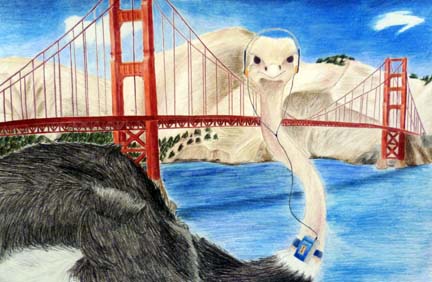 Photo courtesy of Mary Lightbody
Photo courtesy of Mary Lightbody
Peyton Webber, DRHS junior
Golden Gate, colored pencil
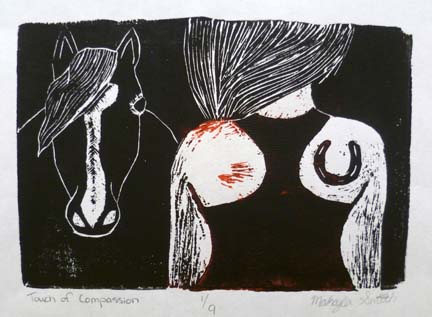
Photo courtesy of Mary Lightbody
Makayla Smith, DRHS senior
compassion, relief print
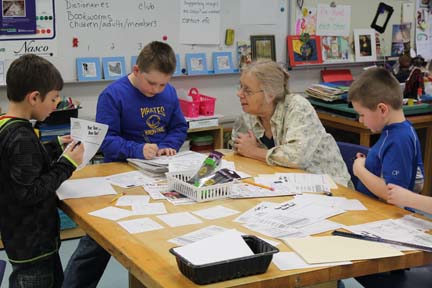
Photo courtesy of Walter Boomsma
FUN IN ADVERTISING — Piscataquis Community Elementary School third-graders, from left, Josh Harrington, Question Blanchard and Riley Snowden work on their ads for the Valley Grange with guidance from art teacher Jane Daniels. The Valley Grange sponsors a pair of ads, one for grade 3 and another for grade 4 at the school in Guilford, in the annual Newspapers in Education supplement in the Piscataquis Observer.
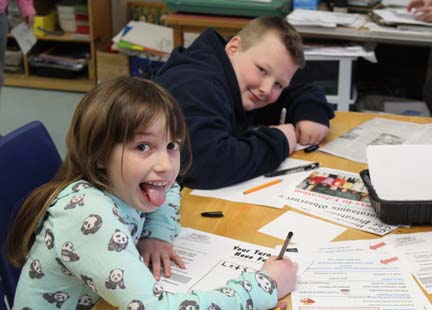 Photo courtesy of Walter Boomsma
Photo courtesy of Walter Boomsma
FUN IN ADVERTISING — Piscataquis Community Elementary School fourth-graders Kamryn Merrill and Beau Talbot design ads for the Valley Grange of Guilford to be considered for publication in the Piscataquis Observer Newspapers in Education edition.
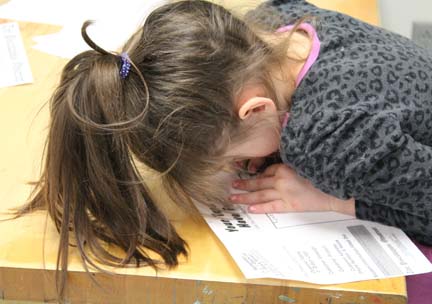 Photo courtesy of Walter Boomsma
Photo courtesy of Walter Boomsma
FULL CONCENTRATION — A student gets close to her Newspapers in Education advertisement for the Valley Grange.
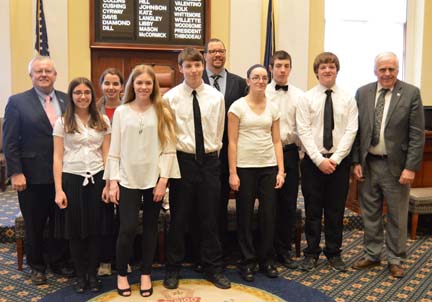 Photo courtesy of Maine State Republican Office
Photo courtesy of Maine State Republican Office
MAKING MUSIC IN AUGUSTA — On March 24 State Sen. Paul Davis (R-Piscataquis), right, and Rep. Paul Stearns (R-Guilford), left, welcomed the Penobscot Community Secondary School’s Jazz Combo to the Statehouse. The PCSS Jazz Combo was visiting for Art Advocacy Day. They were accompanied by director Paavo Carey and Sue Griffith.
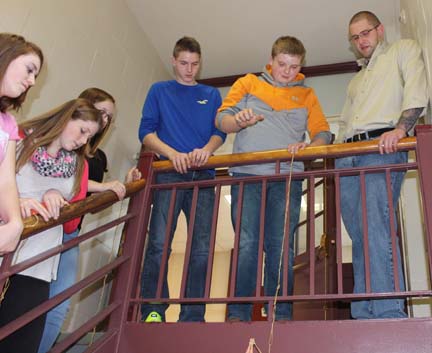 Observer file photo/Stuart Hedstrom
Observer file photo/Stuart Hedstrom
BARBIE BUNGEE JUMP — Foxcroft Academy Algebra I students Michaleb Niles, blue shirt, and Caleb Ladd — who had Mason McLeish in their group — watch as their Barbie doll takes the plunge from the top of the stairwell to the steps near the bottom as part of a lesson in linear functions. Students in Ryan Nickerson’s class used linear functions, a scatterplot app on their iPads and numerous test jumps to calculate how many elastics would be needed to drop Barbie as close to the ground as possible without making contact. Watching the jump are, from left, students Emelia Grant, Heather Burgess and Emily Mooers with Nickerson to the far right.
Family Welcome Nights at Ridge View
By Avery Herrick and Santinaca Lawson
School Reporters
DEXTER — Ridge View Community School (RVCS) held a Family Welcome Night on Sept. 9 for grades K-4 and on the 10th for grades 5-8. RVCS held this Welcome Night to invite parents to meet the teachers and participate in the PTO book fair.
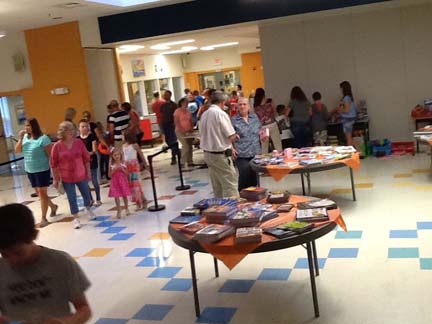 Contributed photo
Contributed photo
BACK TO SCHOOL — Families of students at the Ridge View Community School in Dexter attended a pair of Welcome Nights, with K-4 on Sept. 9 and grades 5-8 on Sept. 10.
Family Welcome Night showcased our school organizations and activities. Other community organizations participated like the police department, Kiwanis, Boy Scouts and Girl Scouts. This year ¼s Welcome Night was more about the parents and family to make them feel more involved with our school.
There were many families that attended Family Welcome Night and they enjoyed our many door prizes awarded. RVCS is off to a magnificent start!
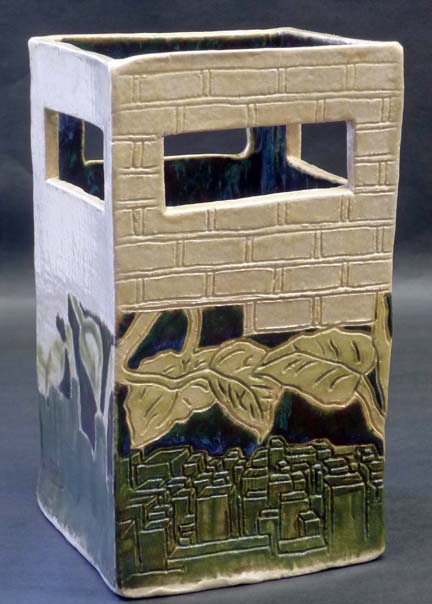 Photo courtesy of Mary Lightbody
Photo courtesy of Mary Lightbody
Jade Harvey, DRHS senior
stoneware
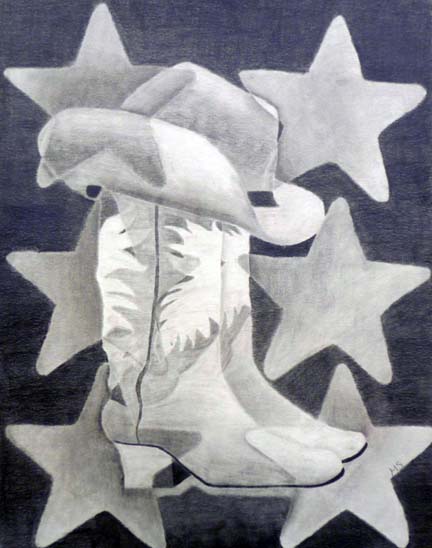
Photo courtesy of Mary Lightbody
Makayla Smith, DRHS senior
graphite
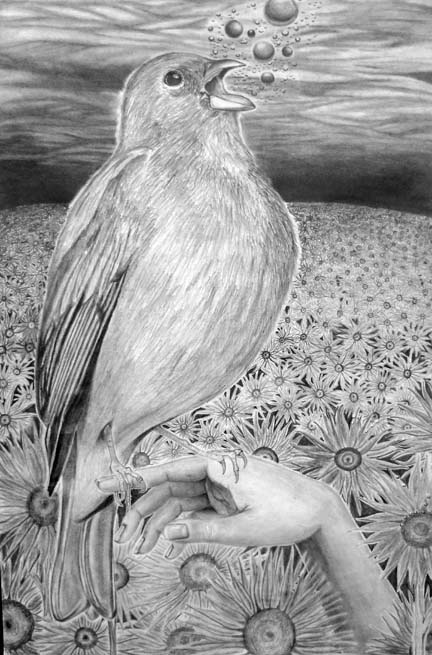
Photo courtesy of Mary Lightbody
Jade Harvey, DRHS senior
fly away, graphite
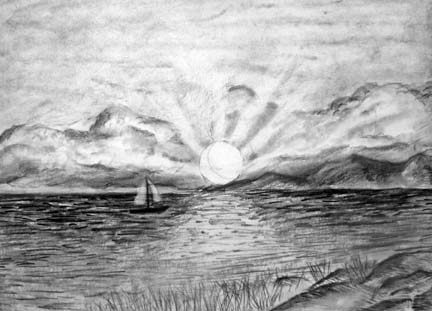
Photo courtesy of Mary Lightbody
Mark Kilmer , DRHS freshman
Wassookeag, graphite
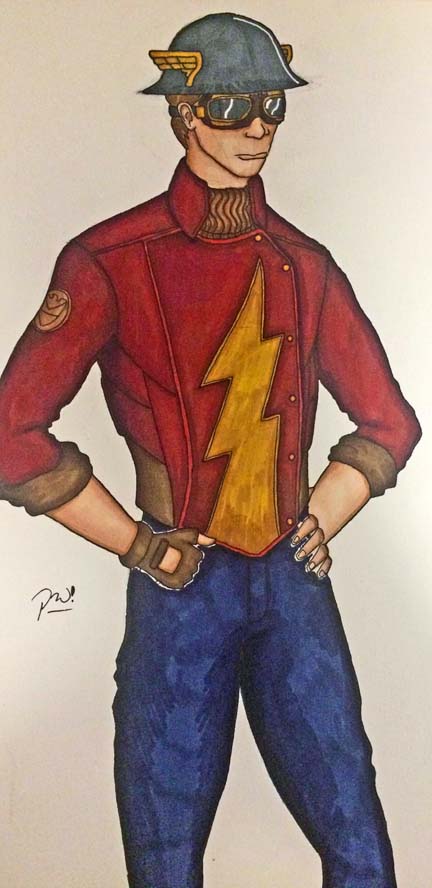
Photo courtesy of Mary Lightbody
Peyton Webber, DRHS junior
Flash, Prismacolor markers
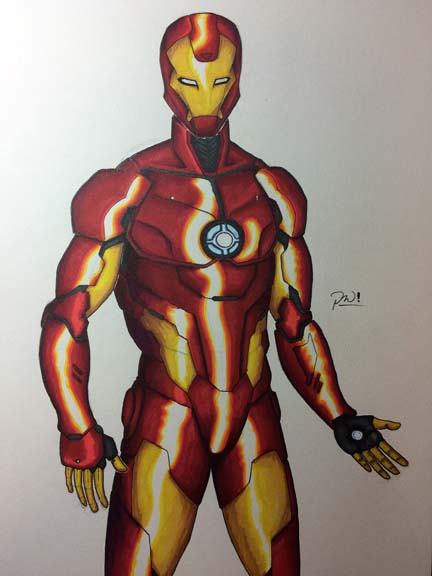
Photo courtesy of Mary Lightbody
Peyton Webber, DRHS junior
Ironman, Prismacolor markers
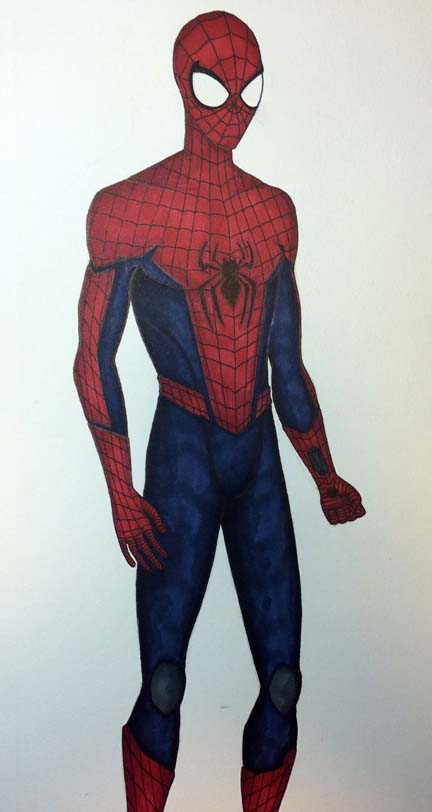
Photo courtesy of Mary Lightbody
Peyton Webber, DRHS junior
Spiderman, Prismacolor markers
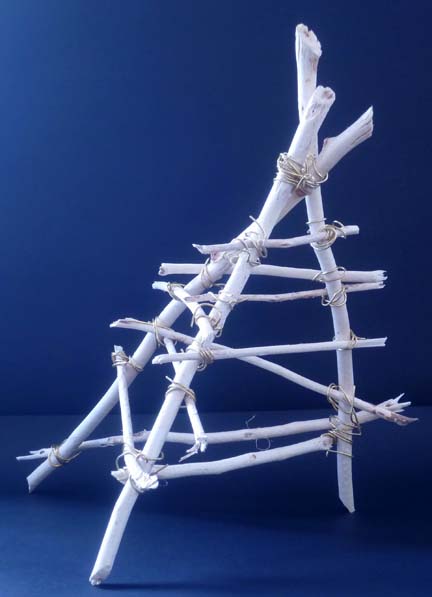
Photo courtesy of Mary Lightbody
Autumn-Mae Young, DRHS senior
sculpture, beaver sticks, brass wire

Photo courtesy of Mary Lightbody
Rebecca Batron, DRHS sophomore
watercolor
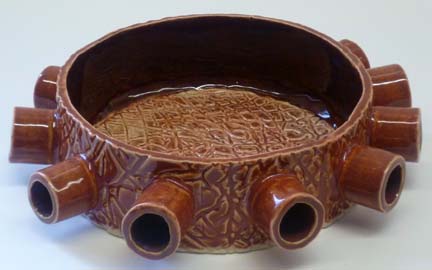
Photo courtesy of Mary Lightbody
Airiell Knowlton, DRHS senior
stoneware
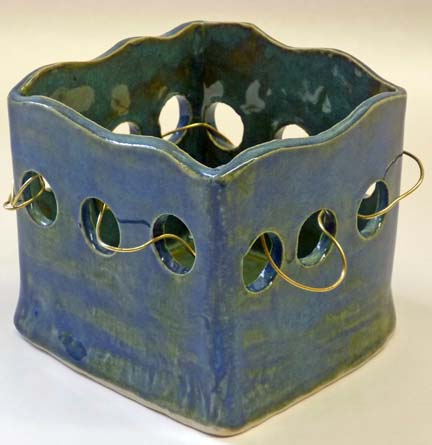
Photo courtesy of Mary Lightbody
Stacey Allen, DRHS senior
stoneware
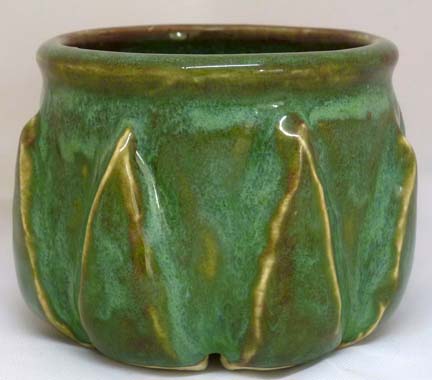
Photo courtesy of Mary Lightbody
Arielle Carlow, DRHS senior
stoneware